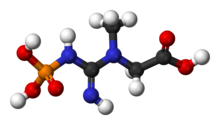
| |

| |
| Names | |
|---|---|
| IUPAC name
N-Methyl-N-(phosphonocarbamimidoyl)glycine
| |
| Other names
Creatine phosphate; phosphorylcreatine; creatine-P; phosphagen; fosfocreatine
| |
| Identifiers | |
3D model (JSmol)
|
|
| Abbreviations | PCr |
| 1797096 | |
| ChEBI | |
| ChEMBL | |
| ChemSpider | |
| DrugBank | |
| ECHA InfoCard | 100.000.585 |
| EC Number |
|
| KEGG |
|
PubChem CID
|
|
| UNII | |
CompTox Dashboard (EPA)
|
|
| |
| |
| Properties | |
| C4H10N3O5P | |
| Molar mass | 211.114 g·mol−1 |
| Pharmacology | |
| C01EB06 (WHO) | |
| Hazards | |
| GHS labelling: | |

| |
| Warning | |
| H315, H319, H335 | |
| P261, P264, P271, P280, P302+P352, P304+P340, P305+P351+P338, P312, P321, P332+P313, P337+P313, P362, P403+P233, P405, P501 | |
Except where otherwise noted, data are given for materials in their standard state (at 25 °C [77 °F], 100 kPa).
| |
Phosphocreatine, also known as creatine phosphate (CP) or PCr (Pcr), is a phosphorylated form of creatine that serves as a rapidly mobilizable reserve of high-energy phosphates in skeletal muscle, myocardium and the brain to recycle adenosine triphosphate, the energy currency of the cell.